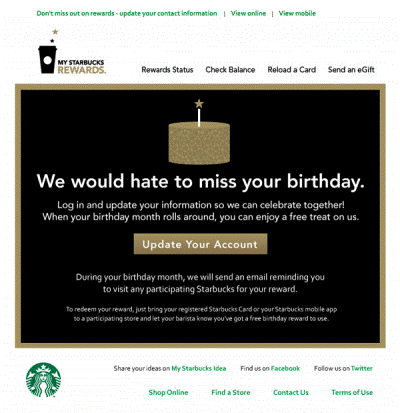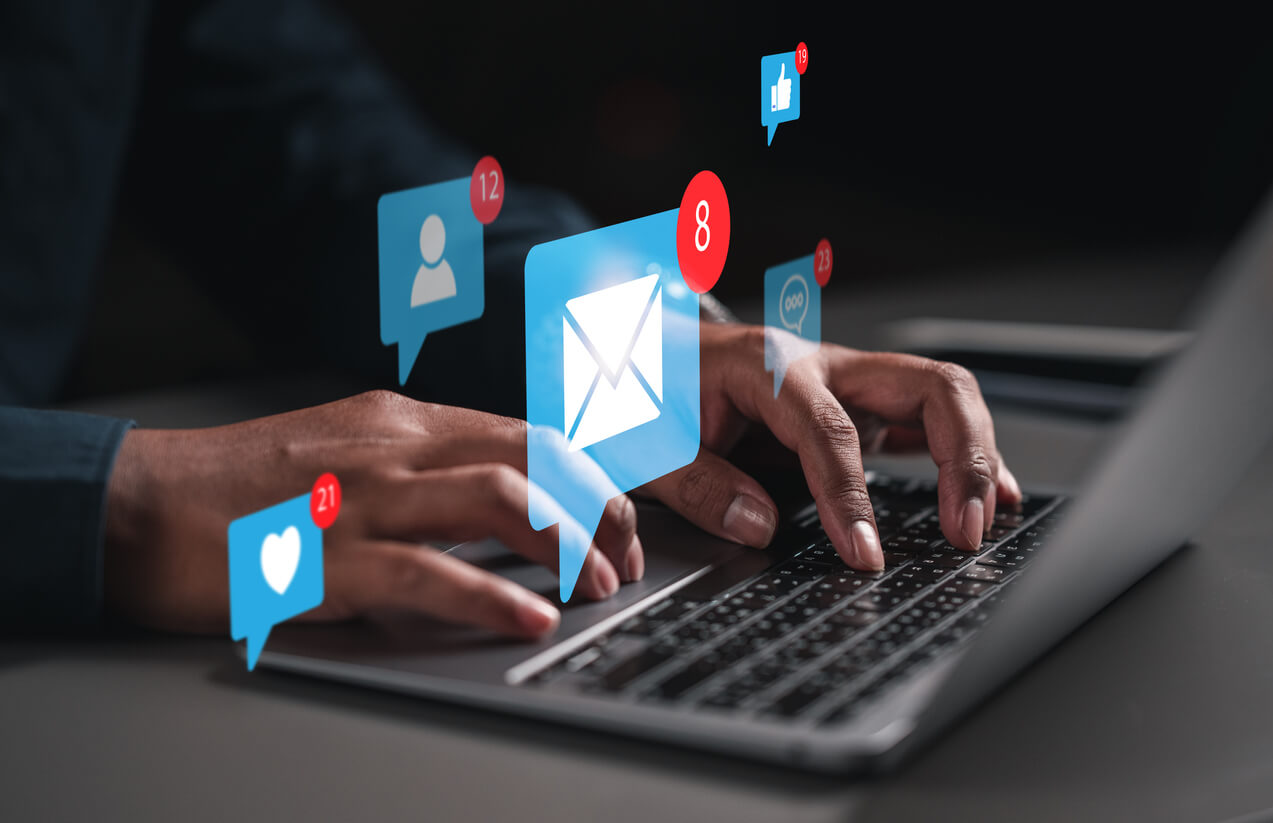Maintaining an engaged audience can be a constant challenge for marketers today. But what if you could rekindle the interest of those who have drifted away?
Read on as we dive into email re-engagement tactics and strategies to win back your valuable audience.
What is Email Re-Engagement?
Email reactivation or email re-engagement is a strategy to reconnect with subscribers or customers who have gradually become disengaged. It’s a proactive attempt to regain their attention, interest, and ultimately, their loyalty. Instead of letting inactive contacts fade away, email re-engagement seeks to reestablish a connection and rekindle the relationship.
Why Do Subscribers Disengage with Emails?
Disengagement can occur for various reasons, often due to shifts in user behavior, evolving preferences, and changes in their needs.
Here are some common reasons why email disengagement happens:
Poor Product or Service Experience
A poor experience with the product or service, high prices, poor shipping options, unimpressive product release, or fierce competition with valid alternatives to your product can all lead to disengagement.
Lack of Personalization
Generic or irrelevant content can cause disengagement. Subscribers expect emails tailored to their interests, and failing to meet this expectation can lead to disinterest.
Frequency Overload
Sending emails too frequently can overwhelm subscribers and cause them to tune out. A study by Marketingsherpa found that the most common reason (26%) for unsubscribing from an email list was “get too many emails.” Bombarding them with too many messages reduces the impact of each email.
Email overload may also occur due to holidays like Thanksgiving, Christmas, or New Year or huge shopping events like Back-to-School or Black Friday and Cyber Monday.
Change in Interests
Over time, subscribers’ interests and needs might evolve. Research shows that 38% of people unsubscribe from emails they are no longer interested in. If your content doesn’t resonate with them, they might lose interest and disengage.
Change of Email Address
If subscribers change their email address and fail to update their information, they won’t receive your emails, causing disengagement.
According to Omnisend, here’s how to tell when your customers are inactive and need to be won back:
- 90 days of inactivity: The customer is beginning to lose interest in your brand.
- 90-120 days of inactivity: The customer is at a high risk of lapsing. You’re about to lose them.
- 120-180 days of inactivity: The customer has lapsed. They no longer interact with your brand.
Why Email Re-Engagement Matters
Maintaining a healthy email list is essential for effective marketing. An engaged audience is more likely to open emails, click through content, and make purchases.
Additionally, acquiring a new customer can cost five times more than retaining an existing customer. So, focusing on re-engaging your existing customers is well worth the effort.
6 Segmentation Tactics for Email Re-Engagement
Segmentation is a powerful tool when it comes to crafting effective email re-engagement campaigns. It allows you to tailor your messages to specific groups of disengaged subscribers based on their behaviors, preferences, and interaction history.
Here are some segmentation tactics to consider for your email re-engagement campaigns:
1. Last Interaction
Segment based on the last time a subscriber interacted with your emails. Subscribers who haven’t engaged in a long time might need a stronger incentive to reengage compared to those who’ve been slightly inactive.
2. Purchase History
By analyzing their purchase history. Create tailored reactivation emails suggesting complementary products or exclusive offers based on their previous purchases.
3. Demographics
Segment by demographics such as age, location, gender, or job title. Customize your reactivation emails to resonate with their specific characteristics.
4. Purchase Frequency
Segment subscribers based on how frequently they’ve made purchases in the past. Offer loyalty rewards or discounts to encourage them to return.
5. Inactivity Duration
Segment by the duration of inactivity. Subscribers who’ve been disengaged for a longer period might need a more compelling reactivation email to grab their attention.
6. Purchase Value
Segment by the average purchase value. Offer personalized incentives or rewards that align with their spending habits.
Email Re-Engagement Subject Line Tips
Subject lines are the first thing recipients see in their inbox, and they determine whether your email gets opened or goes ignored. In fact, 47% of email recipients will decide whether or not to open an email based on the subject line.
Crafting a compelling subject line is crucial to capturing the attention of disengaged subscribers and enticing them to rediscover the value your brand offers.
- Incorporate the recipient’s name to add a personal touch. A subject line like “We Miss You, [Name]!” adds a warm and personal element that can pique curiosity.
- Use intriguing subject lines that spark curiosity without revealing everything. For example, “Guess What? Something Special Awaits You” leaves room for recipients to wonder what’s inside.
- Emphasize the exclusivity of your offer with subject lines like “Unlock Your Exclusive 20% Off!” This creates a sense of privilege and urgency.
- Subject lines that ask questions can engage recipients and encourage them to open the email for answers. “Have You Seen What’s New?” prompts curiosity about updates they might have missed.
- Utilize urgency by highlighting limited-time offers. Subject lines like “Last Chance for 50% Off!” evoke a fear of missing out (FOMO) and encourage quick action.
- Clearly communicate the value recipients will get from opening the email. Subject lines like “Revamp Your Wardrobe with Our Latest Collection” convey the benefit directly.
- Action-oriented subject lines inspire recipients to take action. “Discover,” “Grab,” or “Unveil” can prompt immediate engagement.
- Emotionally charged subject lines resonate with recipients. “Rediscover the Joy of Shopping” taps into the sentiment associated with your brand.
- Highlight their past interactions with your brand. “You Loved These Before – Check Out What’s New!” triggers a sense of familiarity and interest.
- Keep subject lines concise and to the point. A short subject line like “Your Exclusive Comeback Offer” delivers the message quickly.
Also, be sure to provide a compelling reason for them to reengage. This could be an exclusive discount, access to new content, or a sneak peek into upcoming offerings.
Direct them toward a specific action, whether it’s visiting your website, updating their preferences, or exploring new products.
Timing and Frequency of Email Re-Engagement Campaigns
Sending re-engagement emails at the right time is crucial. Avoid bombarding them; instead, choose strategic intervals after periods of inactivity to gently remind them of your presence.
Research shows that the average length of time between when people received a re-engagement email and when they read a subsequent message was almost 2 months (57 days). Additionally, 75% of subscribers clicked on a subsequent message within 89 days.
A/B Testing
Experiment with different elements of your re-engagement emails, such as subject lines, visuals, and offers. A/B testing helps you identify the most effective strategies for each segment.
Setting Up Automated Workflows
Automate your re-engagement process using triggered workflows. For instance, if a subscriber hasn’t engaged for a certain period, an automated email can be sent to rekindle their interest.
Examples of Great Re-Engagement Campaigns from Top Brands
1. Paul Mitchell
This example from Paul Mitchell uses humor, fun imagery, a reminder about why their emails provide value, and a clear call to action.
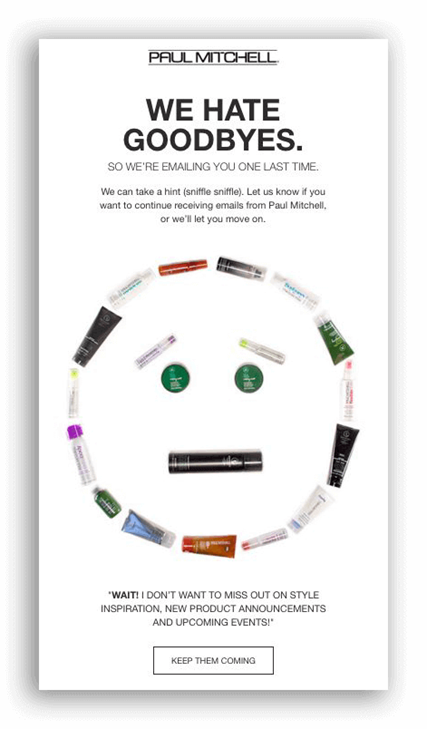
2. Teespring
This winback campaign from Teespring checks the box for several best practices. It appeals on an emotional level (hello, who doesn’t love a cute puppy?), as well as includes a personalized reminder about the value the platform brings.
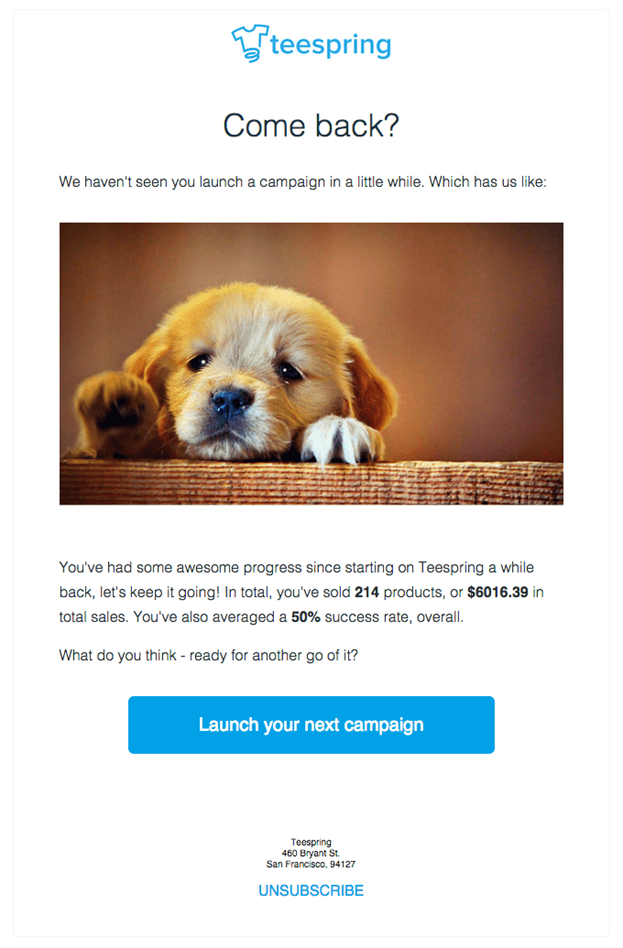
3. Anne Taylor
In this re-engagement example from Ann Taylor, the email starts off with the customer’s first name and includes a compelling offer of a $ discount.
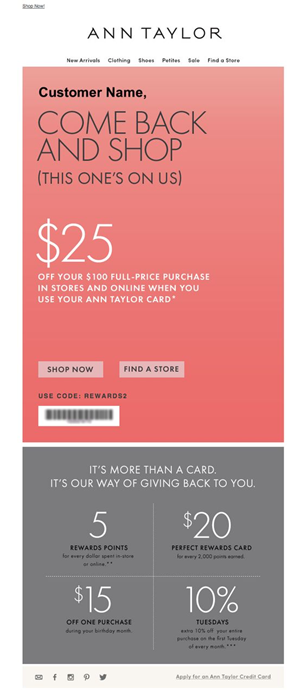
4. GoPro
GoPro uses imagery that appeals to its user base as well as a fun twist on words with its copy and call-to-action buttons.
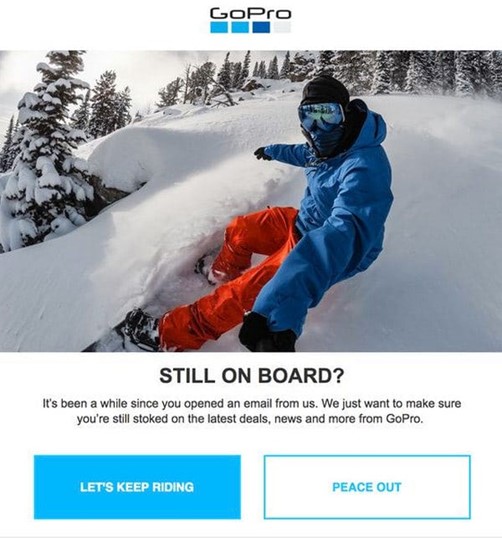
5. Lowes
In this example, Lowes uses simple yet creative imagery, with just a few simple lines of copy and two buttons.
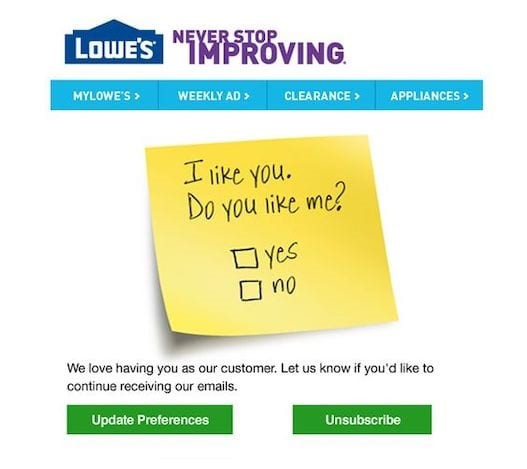
6. Starbucks
Starbucks uses a simple yet highly effective technique by asking for a lapsed customer’s birthday in exchange for a freebie.
